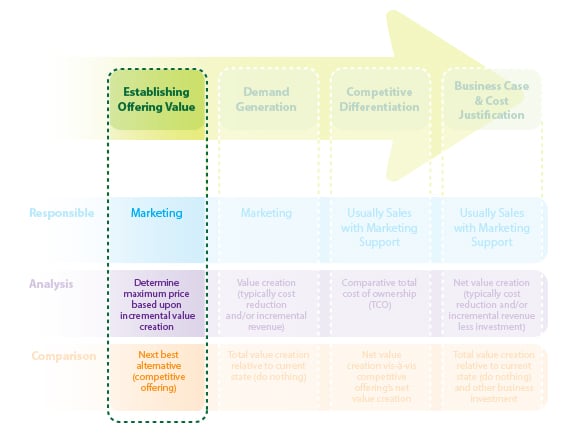 This is Part II of a five-part series about the value lifecycle in B2B selling and marketing. This installment explores how to establish the value of your offering.
This is Part II of a five-part series about the value lifecycle in B2B selling and marketing. This installment explores how to establish the value of your offering.
Although value in a B2B context is always about dollars and cents, value and price are not the same thing. When marketers start the process of setting a price for a product or solution, they usually look around to see what the competition is charging, and then they set a similar price. Or they look at their costs and tack on an acceptable margin.
That’s the wrong way to look at things. You need to first do the hard work to understand the value of your offering.
Value starts with looking at the economics of the customer and doing a pro/con analysis of your offering against their next best alternative. Sometimes that’s a competitor’s offering. However, it’s often “do nothing” or pursuing a homegrown solution that’s created internally.
If you add up those pros and cons (your value elements), you can establish the value your offering creates for a customer based on what you do differently. That value should be measurable in currency and should be specific to each customer (or segment). Once you do this analysis, you can set price. Here’s the formula: the maximum price you can charge is the value you create minus the value of the next best alternative, plus the price of the next best alternative. However, you cannot charge the maximum price, because at that price the customer has no incentive to change, because at that price you are leaving no value for your customer. You need to share some or even a significant majority of the value your offering creates to incent customers to buy and sustain your market.
As an example, let’s look at the B2B marketing and sales enablement tools that my company sells. Part of the value we create is additional leads and more closed deals. While our competitors may not be able to offer customers as many incremental leads and closed deals, they still offer something along those lines. The big value we create over our competitors is our consulting services -- not only do we create the tool, we help our clients define and communicate the value of their offering in terms their customer will understand and accept. This not only makes the tools more effective but also gives our clients an inherent time-to-market advantage. Our pricing strategy is to then capture some of this incremental value we create vis-à-vis the next best alternative, which can be either “do nothing” or a competitive product (a competitive product could include an internal homegrown tool).
In our view, all marketers should spend time doing this analysis, but figuring out incremental value is a difficult task. That’s why many marketers take the easy route and set a price based on how much it costs them to make their product, or they take the competitor’s price and simply charge a 10 percent premium or discount. But neither of those things helps you establish your value, nor does it allow you to capture an optimal share of that value.
Phase 1 is all up to the product or marketing manager, but these decisions will heavily affect the sales team later in the value life-cycle when trying to find leads and close deals.
Next week we’ll explore Phase 2, demand generation.
Has your company/team performed an analysis like this to determine your value? What are some lessons you’ve learned about value and pricing in your career? Share your thoughts in the comments section.








